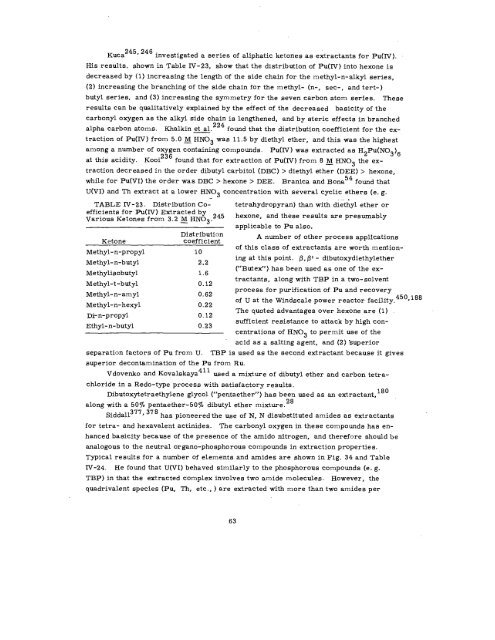THE RADIOCHEMISTRY OF PLUTONIUM - Sciencemadness.org
THE RADIOCHEMISTRY OF PLUTONIUM - Sciencemadness.org
THE RADIOCHEMISTRY OF PLUTONIUM - Sciencemadness.org
Create successful ePaper yourself
Turn your PDF publications into a flip-book with our unique Google optimized e-Paper software.
~uca245,246 . investigated a series of aliphatic ketones as extractants for Pu(IV).<br />
His results, shown in Table IV- 23, show that the distribution of Pu(lT.T ) into hexone is<br />
decreased by (1) increasing the length of the side chain for the methyl- n-alkyl series,<br />
(2) increasing the branching of the side chain for the methyl- (n-, see-, and tert-)<br />
butyl series, and (3) increasing the symmetry for the seven carbon atom series. These<br />
results can be qualitatively explained by the effect of the decreased basicity of the<br />
carbonyl oxygen as the alkyl side chain is lengthened, and by steric effects in branched<br />
alpha carbon atoms. Khalkin ~.224 found that the distribution coefficient for the ex-<br />
traction of Pu(IY) from 5.0 M HN03 was 11.5 by diethyl ether, and this was the highest<br />
—<br />
among a number of oxygen containing compounds, Pu(IV) was extracted as H2Pu(N03)6<br />
236<br />
at this acidity. Kooi found that for extraction of Pu(IV) from 8 &f HN03 the ex-<br />
traction decreased in the order dibutyl carbitol (DBC) > diethyl ether (DEE) > hexone,<br />
while for Pu(VI) the order was DBC > hexone > DEE. Branica and Bona 54 found that<br />
U(VI) and Th extract at a lower HN03<br />
-—<br />
concentration with several cyclic ethers (e. g.<br />
TABLE IV-23. Distribution Co- tetrahydropyran) than with diethyl ether or<br />
efficients<br />
Various<br />
for Pu(IV) Extracted by<br />
Ketones from 3.2 ~ HN03.245<br />
hexone, and these results are presumably<br />
applicable to Pu also.<br />
Ketone<br />
Methyl -n-p ropyl<br />
Distribution<br />
coefficient<br />
10<br />
A number of other process applications<br />
of this class of extractants are worth mention-<br />
Methyl-n-but yl 2.2<br />
ing at this point. ~, f3! - dibutoxydiethylether<br />
Methylisobut<br />
Methyl-t-butyl<br />
yl 1.6<br />
0.12<br />
(“Butex”<br />
tractants,<br />
) has been used as one of the ex-<br />
along with TBP in a two- solvent<br />
Methyl- n-amyl<br />
Methyl-n-hexyl<br />
0.62<br />
0.22<br />
process for purification of Pu and recovery<br />
of U at the Windscale power reactor facility.<br />
450,188<br />
Di-n-propyl 0.12<br />
The quoted advantages over hexone are (1)<br />
Ethyl- n-butyl 0.23<br />
sufficient<br />
centrations<br />
resistance<br />
of HN03<br />
to attack<br />
to permit<br />
by high con-<br />
use of the<br />
acid as a salting agent, and (2) ‘superior<br />
separation factors of Pu from U. TBP is used as the second extractant because it gives<br />
superior decontamination of the Pu from Ru.<br />
Vdovenko and Kovalskaya<br />
411<br />
used a mixture of dibutyl ether and carbon tetra-<br />
chloride in a Redo-type process with satisfactory results.<br />
Dibutoxytetraethylene glycol (’ ‘pentaether” ) has been used as an extractant,<br />
180<br />
along with a 507’0 pentaether - 5O~o dibut yl ether mixture.<br />
28<br />
Sidda11377, 378<br />
has pioneered the use of N, N disubstituted amides as extractants<br />
for tetra- and hexavalent actinides. The carbonyl oxygen in these compounds has en-<br />
hanced basicity because of the presence of the arnido nitrogen, and therefore should be<br />
analogous to the neutral <strong>org</strong>ano-phosphorous compounds in extraction properties.<br />
Typical resdts for a number of elements and amides are shown in Fig. 34 and Table<br />
IV-24. He found that U(VI) behaved similarly to the phosphorous compounds (e. g.<br />
TBP) in that the extracted complex involves two amide molecules. However, the<br />
quadrivalent species (Pu, Th, etc., ) are extracted with more than two amides per<br />
63
















